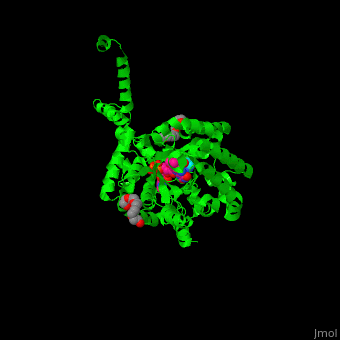Proline utilization A
From Proteopedia
(Difference between revisions)
| (One intermediate revision not shown.) | |||
| Line 1: | Line 1: | ||
<StructureSection load='' size='350' side='right' caption='E. coli PutA proline dehydrogenase domain with cofactor FAD complex with hydroxyproline (PDB code [[3e2q]])' scene='70/706260/Cv/1'> | <StructureSection load='' size='350' side='right' caption='E. coli PutA proline dehydrogenase domain with cofactor FAD complex with hydroxyproline (PDB code [[3e2q]])' scene='70/706260/Cv/1'> | ||
== Function == | == Function == | ||
| - | '''Proline utilization A (PutA)''' is a bifunctional flavoprotein which acts as a transcriptional repressor of the put regulon or as a membrane-bound enzyme which catalyzes the oxidation of proline to glutamate. PutA domains include the DNA-binding domain (PRODH), the FAD-dependent proline dehydrogenase domain and the D-pyrroline-5-carboxylate dehydrogenase domain. The binding of proline to the PRODH active site and subsequent reduction of FAD causes a conformation change in PutA and enhance its membrane affinity. As a membrane-bound protein PutA switches from its repressor activity to its enzymatic role<ref>PMID:19994913</ref>. | + | '''Proline utilization A (PutA)''' or '''bifunctional protein PutA''' is a bifunctional flavoprotein which acts as a transcriptional repressor of the put regulon or as a membrane-bound enzyme which catalyzes the oxidation of proline to glutamate. PutA domains include the DNA-binding domain (PRODH), the FAD-dependent proline dehydrogenase domain and the D-pyrroline-5-carboxylate dehydrogenase domain. The binding of proline to the PRODH active site and subsequent reduction of FAD causes a conformation change in PutA and enhance its membrane affinity. As a membrane-bound protein PutA switches from its repressor activity to its enzymatic role<ref>PMID:19994913</ref>. |
== Structural highlights == | == Structural highlights == | ||
| Line 11: | Line 11: | ||
Updated on {{REVISIONDAY2}}-{{MONTHNAME|{{REVISIONMONTH}}}}-{{REVISIONYEAR}} | Updated on {{REVISIONDAY2}}-{{MONTHNAME|{{REVISIONMONTH}}}}-{{REVISIONYEAR}} | ||
{{#tree:id=OrganizedByTopic|openlevels=0| | {{#tree:id=OrganizedByTopic|openlevels=0| | ||
| + | |||
*PutA | *PutA | ||
**[[4nm9]] – GsPutA + FAD – ''Geobacter sulfurreducens'' <br /> | **[[4nm9]] – GsPutA + FAD – ''Geobacter sulfurreducens'' <br /> | ||
| + | **[[7na0]] – GsPutA (mutant) + FAD <br /> | ||
**[[4nma]] – GsPutA + FAD + tetrahydrofuran derivative <br /> | **[[4nma]] – GsPutA + FAD + tetrahydrofuran derivative <br /> | ||
**[[2gpe]] – EcPutA DNA-binding domain <br /> | **[[2gpe]] – EcPutA DNA-binding domain <br /> | ||
**[[2ay0]] – EcPutA DNA-binding domain (mutant)<br /> | **[[2ay0]] – EcPutA DNA-binding domain (mutant)<br /> | ||
| - | **[[4q71]], [[4q72]], [[4q73]] – | + | **[[4q71]], [[4q72]], [[4q73]] – BdPutA (mutant) + FAD – ''Bradyrhizobium diazoefficiens''<br /> |
**[[4h6r]] – DrPutA + FAD – ''Deinococcus radiodurans''<br /> | **[[4h6r]] – DrPutA + FAD – ''Deinococcus radiodurans''<br /> | ||
**[[2gpe]] - EcPutA DNA-binding domain - ''Escherichia coli''<br /> | **[[2gpe]] - EcPutA DNA-binding domain - ''Escherichia coli''<br /> | ||
**[[2jxg]], [[2jxh]] - PpPutA DNA-binding domain - ''Pseudomonas putida'' - NMR<br /> | **[[2jxg]], [[2jxh]] - PpPutA DNA-binding domain - ''Pseudomonas putida'' - NMR<br /> | ||
| - | **[[ | + | **[[6ufp]], [[6vz9]] – SmPutA (mutant) + FAD – ''Sinorhizobium melioli''<br /> |
*PutA complex | *PutA complex | ||
| Line 43: | Line 45: | ||
**[[3haz]] - PutA + FAD + NAD - ''Bradyrhyzobium japonicum''<br /> | **[[3haz]] - PutA + FAD + NAD - ''Bradyrhyzobium japonicum''<br /> | ||
**[[5ux5]] - PutA + FAD + NAD - ''Corynebacterium freiburgense''<br /> | **[[5ux5]] - PutA + FAD + NAD - ''Corynebacterium freiburgense''<br /> | ||
| - | **[[5kf6]], [[5kf7]] - PutA + FAD + NAD + THF - ''Sinorhizobium meliloti''<br /> | + | **[[5kf6]], [[5kf7]], [[6ufp]], [[6vz9]] - PutA + FAD + NAD + THF - ''Sinorhizobium meliloti''<br /> |
**[[2jxi]] - PpPutA DNA-binding domain + DNA<br /> | **[[2jxi]] - PpPutA DNA-binding domain + DNA<br /> | ||
| - | + | **[[5ur2]] - PutA + FAD derivative + inhibitor - ''Bdellovibrio bacteriovorus''<br /> | |
| + | **[[6x9a]], [[6x9b]], [[6x9c]], [[6x9d]] – SmPutA + FAD + proline derivative <br /> | ||
| + | **[[6x99]] – SmPutA + FAD + Glu derivative <br /> | ||
| + | **[[7my9]], [[7mya]], [[7myb]], [[7myc]] – SmPutA + FAD + dithiolane <br /> | ||
| + | **[[6bsn]] – BdPutA + FAD + proline<br /> | ||
}} | }} | ||
Current revision
| |||||||||||
3D Structures of proline utilization A
Updated on 01-February-2022
References
- ↑ Srivastava D, Zhu W, Johnson WH, Whitman CP, Becker DF, Tanner JJ. The Structure of the Proline Utilization A Proline Dehydrogenase Domain Inactivated by N-Propargylglycine Provides Insight into Conformational Changes Induced by Substrate Binding and Flavin Reduction (,). Biochemistry. 2009 Dec 29. PMID:19994913 doi:10.1021/bi901717s
- ↑ Ostrander EL, Larson JD, Schuermann JP, Tanner JJ. A Conserved Active Site Tyrosine Residue of Proline Dehydrogenase Helps Enforce the Preference for Proline over Hydroxyproline as the Substrate (dagger) (double dagger). Biochemistry. 2009 Feb 10;48(5):951-9. PMID:19140736 doi:10.1021/bi802094k

